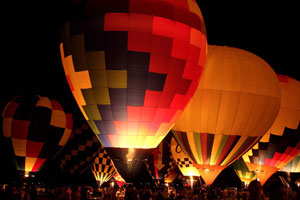
Copyright © Andy Long
Colors, patterns, and brightness are accentuated in a tight grouping.
Photographers wanted. Those not wanting to learn need not apply. Photography is a hobby/profession that demands learning—both about the technical side (how to use the equipment) and the educational side (dealing with the subjects being photographed). For example, wildlife photography requires knowing animal behavior, a knowledge that helps you anticipate the peak of action. If you find out when peak seasons for wildflower bloom and fall color happen in different spots, you can be in the right place at the right time. You also need to be able to identify birds and wildflowers. You’ll find there’s plenty of other practical information that will be useful in your work, as well.
Another direction in which you may want to educate yourself is to find out about the history of the people of an area, the surrounding cultures, or certain events. Many times it’s not necessary to know where or how something started to get nice shots, but background details can be eye-opening. This was the case for me while I was attending a balloon festival in East Texas. Having photographed numerous balloon festivals in the past, I already knew that the glows held at night were my favorite subject. Liftoffs and groupings of balloons in the sky also make nice shots.
While at this particular event, I learned several things that surprised me. The first was that the history of balloon glows can be traced to an unlikely location. While the largest balloon festival in the world is in France and Albuquerque hosts the largest in the United States, the Great Texas Balloon Race in Longview can proudly boast of being the first to stage this interesting event.
|
Copyright © Andy Long A couple of crosses on balloons next to each other draws attention. |
The original sponsor of the festival was the owner of a shopping area who wanted to draw visitors to the location for night shopping. He asked numerous balloonists if they would bring their balloons to the parking lot, set up, inflate the balloons, and turn their burners on occasionally to add a different element for people to see. From there, the event has spread. Every balloon festival features a glow at least one night during the weekend and sometimes two.
At many festivals, only a small group of the balloons entered in the competition show up for the glow. No matter how many participate, the photo opportunities are enjoyable, even if the glow doesn’t last as long as any photographer would like. (The cost of the gas required to execute a glow is a bit high for one to last an hour or two.) At the Great Texas event, though, every balloon participates because balloonists receive points for taking part. Missing out on those points could cost a contender the win in the overall competition. At the event I witnessed, sixty-five balloons took part. With that many, shots of groups of balloons were easy to come by.
Some balloons look a lot better during a glow than others. Part of this difference can be attributed to the color of the balloon: yellows are great but dark colors are not. The main consideration is whether the balloonist has a glow burner or not. Because glows are now a part of every festival, a special burner is available that produces a different flame which lights up the balloon more than those used for flying. Many balloonists have these and the advantage is quite noticeable.
|
Copyright © Andy Long A closer view of a group of balloons shows off the colors and patterns. |
If you’ve been to a festival and enjoyed walking around amongst the balloons on the launch field, you can thank the Great Texas Balloon Race for your experience. Because of the concern balloon pilots had for their balloons, they didn’t want people walking all over the place and stepping on the balloons as they were laid out on the ground. The Texas event came up with the idea of having guards keeping an eye on them and any people who might be approaching. Getting out among the balloons to take photos has made photography at these events much better, not only at glows but also during morning liftoffs where tight shots of a couple balloons close together can create nice pattern and color compositions.
Balloon glow photo tips:
|
Copyright © Andy Long At the end of the National Anthem, all of the pilots hit their burners for a unique sight. |
The key thing about photographing a glow is to get there early. Walking around with a nice camera and lens can sometimes result in a photo sale or two. Balloonists need good images from time to time, and they might ask to look at some of your shots for a variety of uses. Your conversation with them can also provide you with information you wouldn’t have learned otherwise. It was one of the balloonists who mentioned that The Texas festival was the first to hold a glow—an interesting bit of information which the announcer elaborated upon just prior to the glow. Another balloonist told me that the Texas event was the first to allow people to walk around the launch field.
As you walk around, you can select different shaped balloons as the ones you want to concentrate on during the glow. Looking for the color combinations of balloons that are next to each other is also helpful. You should have several ideas in mind before the action starts. Then you’ll be ready if someone wants to take a look at some of your shots of his or her balloon.
Lens choice is fairly easy with this, as a wide-angle zoom is the best option. Don’t take several lenses and try to change them when something else might look good, because the action time is short. If you try to switch back and forth, you’ll miss numerous opportunities. Being able to get close to the balloons will help you choose your lens. It’s difficult to get a group of five or six balloons close together in a shot with a larger lens.
|
Copyright © Andy Long Lie on the ground and shoot up when the pilot hits the burner to light up their face. |
Above all, don’t forget to listen. While some balloonists will do a burst of flame on their own, the announcer will perform a countdown when almost every balloonist will turn on his or her flame at the same time. At the East Texas festival, they did something called a “flicker” that I hadn’t seen before, where the flames would be turned on and off repeatedly in short bursts to make the balloons light on and off in rapid succession.
Another good idea is to lie down. Get on the ground right next to the balloon. When they turn on the flame, take several shots to get the flame and also it lighting up those who are in the balloon. You won’t catch the color of the balloon this way, but it provides you with another element to help you tell the story of the event.
Using a flash is optional. It gives different effects when used on a full balloon, although it does change the color of the balloon a bit. A flash works best when you’re taking shots of the pilot and the others in the basket. Even with the flame going, it can pop that extra light on their faces when the flame is behind them. Not a lot of flash is needed for this, as shooting at full power will cause an over-exposure of the image. Shooting at between –1 and –2 flash compensation works best.
|
Copyright © Andy Long A shot of a single balloon can be one the balloon owner might want, especially when there is a sponsor involved. |
The use of a tripod is also a good idea. Because the glow doesn’t start until the sky is completely dark, exposure times can vary widely based on the brightness of the balloons in the composition. A tripod helps you create sharper images. Having someone along to hold the tripod when you lie on the ground is also helpful, because there are lots of people walking around in the dark and it might get stepped on.
Related to the use of a tripod and the low light conditions, bumping up the ISO on digital cameras is also useful. A rating of at least 400 and possibly 640 or 800 is recommended. Cameras today can handle the higher ISO’s and can produce usable images even when shot at 1600 and even 3200, when conditions warrant.
Lastly, have fun. If you’ve never been to a balloon festival, find one near you and go. They’re held all over the country. You’ll even find different events happening in numerous cities within a single state throughout the year. Shooting glows might not be something you want to do exclusively, but attending even one festival will be enjoyable and no doubt will provide you with a collection of good shots.
by Andy Long

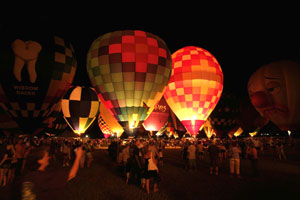
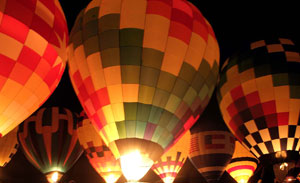
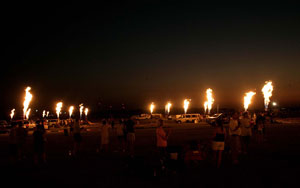
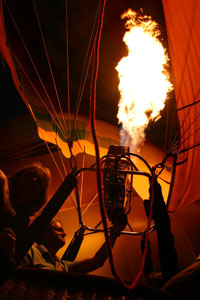
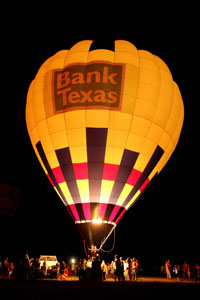
Leave a Reply